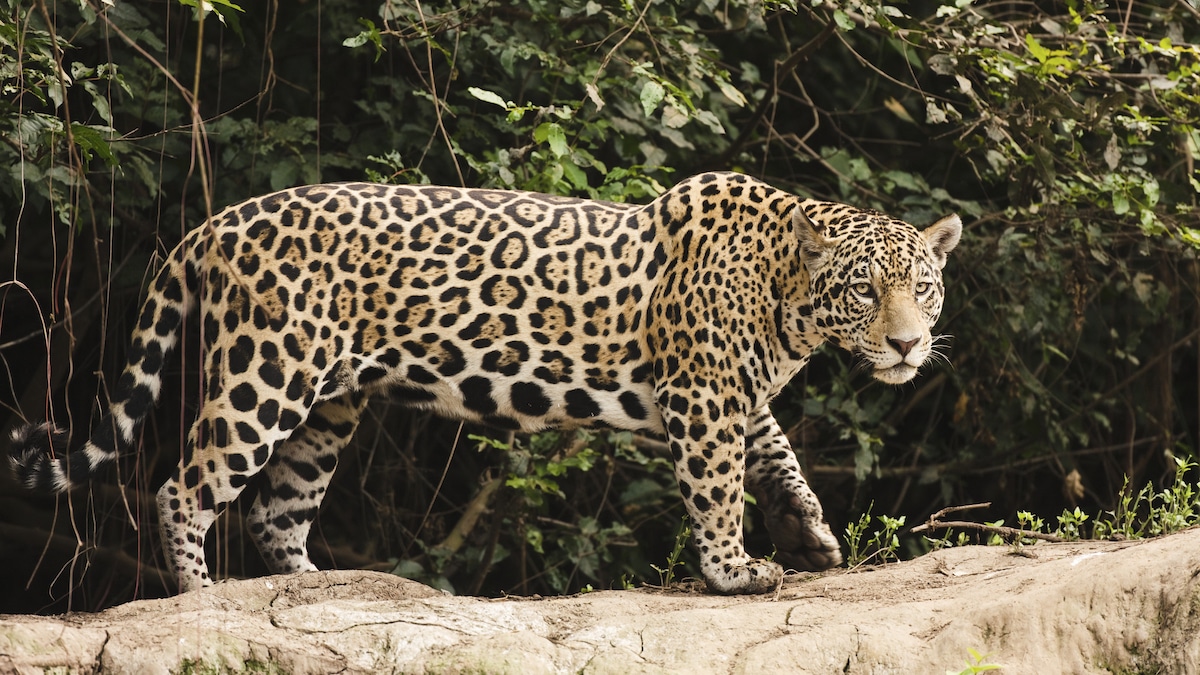

Once found all the way from central Argentina to the Southwestern U.S., the powerful and elegant jaguar is the only big cat in the Americas and the third largest in the world after lions and tigers. These beautiful cats differ from leopards, who inhabit Asia and Africa, mainly in size — jaguars are bulkier and more muscular — and their signature spots are somewhat different from leopards’ in appearance and abundance. “Jaguar” comes from the Indigenous “yaguar,” meaning “he who kills with one leap,” according to WWF-UK.
Jaguars’ territory has shrunk by half since the 1880s, the National Geographic website states. Their habitat has been destroyed by deforestation, which causes habitat fragmentation and reduced range that can lead to inbreeding. Jaguars are also threatened by poaching and killing by ranchers.
Jaguars are now mainly found in the Amazon rainforest of Brazil and in the world’s largest tropical wetland, the Pantanal, said WWF-UK.
As apex predators — apex predators are at the top of the food chain with no natural predators — jaguars have a diet that includes over 85 species, from deer and fish to caimans.
With a population ranging from 64,000 to 173,000, jaguars are on the International Union for the Conservation of Nature’s Red List as a “near threatened” species, and their populations are decreasing fast.
Right now, jaguars can be found as far north as northwestern Mexico in the state of Sonora, which borders Arizona, The Conversation reported.
But what if the jaguar could be given a path to once again move farther northward and repopulate the Southwestern U.S.?
“The most important reason to reintroduce jaguars to the CANRA [the Central Arizona — New Mexico Recovery Area] is that jaguars living once again in central Arizona and New Mexico will add a distinct and unique habitat type to the kaleidoscope of ecosystems where jaguars occur, thus enhancing ecological representation for the species,” said the authors of the study, “The case for reintroduction: The jaguar (Panthera onca) in the United States as a model,” published last year in the journal Conservation Science and Practice.
The authors of the study said that the reintroduction of the jaguar to these areas could also improve the quality of the ecosystems by adding another apex predator. Mexican wolves were reintroduced in 1998.
According to Ganesh Martin, Ph.D. candidate in wildlife conservation and management at the University of Arizona and John Koprowski, dean of University of Wyoming’s Haub School of Environment and Natural Resources, there are only two ways for jaguars to migrate to the U.S. from Mexico via natural pathways, The Conversation reported.
“In our view, maintaining these corridors is crucial to connect fragmented habitats for jaguars and other mammals, such as black bears, pumas, ocelots and Mexican wolves. Increasing connectivity – linking small patches of habitat into larger networks – is a key strategy for conserving large animals that range over wide areas and for maintaining functional ecological communities,” Martin and Koprowski wrote.
Last year Martin and Koprowski filmed a young jaguar they named El Bonito in the borderlands of the U.S. and Mexico. But on the footage it turned out that, after examining the unique spots on each jaguar, there were actually two. They named the second jaguar Valerio.
Male jaguars roam around to find territories and mates, the authors said. Their home ranges can be about 15 to 400 square miles.
Martin and Koprowski recorded Valerio and El Bonito two miles south of the border between the U.S. and Mexico, north of which is a natural corridor called Guadalupe Canyon.
In the past decade, the jaguar population has increased in Mexico to an estimated 4,800, according to a study last year, the authors said. They noted that, as the Sonora jaguar population increases, so does the chance that females might migrate north and mate with the male jaguars in the borderlands.
“Creating natural protected areas that could support breeding populations and offer routes for northward expansion would help accelerate natural recolonization of jaguars into the U.S. Multiple institutions and scientific research projects have highlighted the need to keep natural corridors open to maintain habitat for diverse communities of plants and animals,” said Martin and Koprowski, as The Conversation reported.
The researchers said that 28 other mammal species have been recorded by their camera traps, including black bears, pumas and ocelots, and that all of them need wildlife corridors for their long-term survival.
“In our view, making it possible for jaguars to naturally recolonize suitable habitat in the U.S. is a unique opportunity to foster animal movement in the borderlands. Keeping these landscapes connected will benefit all species in this ecologically unique region that serves as a wildlife source and pathway,” Martin and Koprowski said.

 233k
233k  41k
41k  Subscribe
Subscribe 